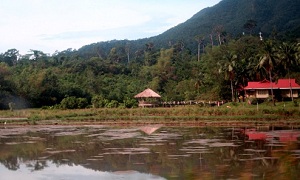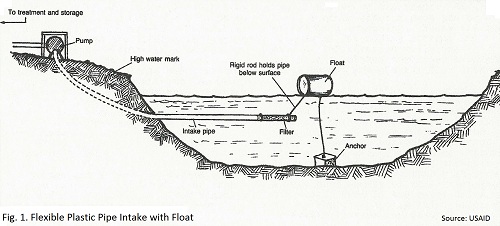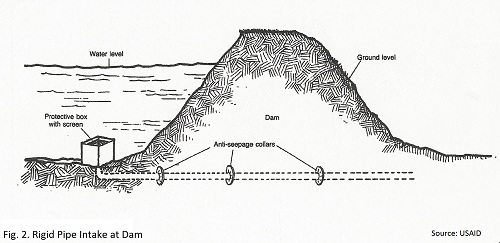Clean Pond Water and Clean Lake Water May Be Made Available for Some Communities
Clean pond water and clean lake water may be made drinkable and safe for some communities.
Note: The content on this page has been adapted from technical notes published by USAID, entitled “Water for the World”.
Ponds and lakes exist where surface run-off has accumulated in depressions or where a dam has been built to form a reservoir. Clean pond water and lake water can be good sources of drinking water for a community if the watershed feeding the pond or lake is uninhabited and the introduction of fecal matter and animal waste is limited.

With good planning, adequate supplies of water will be available for community consumption throughout the year.
Furthermore, the amount of available clean pond water is readily apparent and access to it is easier than to groundwater.
Because ponds and lakes are fed by surface run-off, some kind of treatment is always necessary. This is especially true in smaller community ponds.
Another requirement of ponds and lakes is that water usually must be pumped through a distribution system to the point of use. Pumping machinery is expensive and requires a well-organized operation and maintenance program, and an energy source to operate the pump.
Intakes
To use water from ponds an intake is needed. Clean pond water flows by gravity or is pumped from the intake to treatment and then into storage.
There are two methods typically used.
1. Floating flexible plastic pipe intake
2. Anchored galvanized steel pipe intake
The location of intakes for ponds and lakes depends on the size and depth of the water source, the quality and condition of the water, and the cost of delivering water to the community. An intake should be placed near or in the deepest part of the pond or lake.
At the deepest point, the intake will make maximum use of stored water and will generally be far enough away from the shore to prevent contamination by people and animals. In larger bodies of water the quality of water should improve greatly as distance from the shore to the intake increases.
The depth of the intake in the water is another important consideration. For ponds and medium-sized lakes, a general rule is that the intake should be 0.3-0.5 meters below the surface. If the intake is placed closer than 0.3 meters from the surface, floating debris, algae and aquatic plants may clog the intake screen and pipe.
Constant maintenance would be required to keep the intake in operation.
Another problem is that water containing plant life and organic matter may contain harmful bacteria and other pathogens and have an unacceptable taste and odor.
An intake placed too near the bottom of a pond or lake may draw in very turbid water or water containing a large quantity of suspended solids. Sediment and solids will clog the system and increase maintenance costs. Turbid water, if not treated, will be unacceptable to the users.
In summary, pond and lake intakes should be located so that clean pond water enters the system. Their location must prevent the drawing of water contaminated by contact with humans and animals, or by organic material and suspended matter. Proper location of the intake will help ensure that suitable water is available to the community.
Generally, developing intakes for ponds and lakes is expensive. The further away the users are from the source, the more expensive the system. Where possible, the source of clean pond water and its intake should be located near the community.
Floating Flexible Pipe Intakes
A flexible pipe can be attached to a float and anchored so that it rests between 0.3m and 0.5m from the surface of the water. A floating intake ensures that clean pond water is drawn from the same level regardless of changes in the water level.

The float rises and falls with the water level but the intake remains the same. The intake is placed far enough below the water's surface to prohibit the entrance of any organic matter floating near the surface.
Galvanized Steel Intakes
A variation of the above method can also be considered. In a newly dug reservoir or in a pond where a dam is to be built, a screened concrete intake box can be located on the floor of the reservoir next to the dam embankment. The water is deepest near the embankment and thus will be free from organic material as it enters the intake.

A galvanized steel intake pipe is connected to a screened concrete storage box located on the reservoir floor near a dam's embankment.
This system functions in the same manner as the floating flexible pipe intake, except that the intake is nearer the bottom of the reservoir. The water generally will be cooler and may be free of vegetation which often floats near the surface. A 10 mm screen on the top of the box filters out any suspended matter or debris drawn to the intake
A lower intake like this takes advantage of somewhat cooler water below the surface. Water from the intake is either pumped directly into the distribution system or to treatment and then into the distribution system.
The decision to adopt this method should be made before the dam is constructed since it is less easily installed in existing reservoirs. The expertise needed for construction and high cost make this method a less attractive choice.
This type of intake is permanent, quite expensive, and can only be constructed in a newly- excavated reservoir.
Floating intakes, which are usually cheaper to build, should be installed under most conditions.
Initial Treatment of Pond or Lake Water
The quantity of water available from ponds and lakes may not be a problem but quality will be a question. Generally, water from ponds and lakes must receive some treatment whether at a central facility or in the household. Also, algae and decaying plants may give the water a taste unacceptable to the user, causing him to seek other water sources.
If the water is very cloudy and sediment-laden, treatment may consist of
(a) a settling basin, which allows large particles to settle out of the water and
(b) a filtration unit where water must pass through a filter bed of sand and gravel before entering storage.
For most pond waters, it should be sufficient to pump the water into a small holding tank and then allow it to flow onto a filter bed.
Because of the many variables involved and the cost of treatment, the use of water from ponds and streams should be carefully evaluated.
Return to "Surface Water" from "Clean Pond Water"
Return to "Home"









